Working Group 7.2
Fit-for-purpose (FFP) implementation
Policy Issues
Many people do not have tenure security. Less than 30% of land rights
are documented. Linking people to polygons of land should happen in a fair
way. The Fit-For-Purpose (FFP), Land Administration approach, argues for
cost-effective and timeefficient, transparent, scalable and participatory
land administration.
During the previous terms, the Commission contributed to the
development of the approach and underlined the importance of FFP as a
mechanism to optimise resources and, therefore, expand the coverage of
land administration system.
A great understanding and adoption of the concept are being achieved.
However, further work is required for improving implementation mechanisms.
In particular, methods and procedures are needed to identify purposes and
selecting the best fit for each situation and to find ways to accommodate
to legal national frameworks and to gain legal security for landowners by
visible agreement by decision makers.
This working group will focus on collecting experiences and lessons
from projects in the world where principles of the FFP approach were
applied. The experiences and results will be discussed and shared. This
will support surveyors understand better how to implement FFP in cadastre
and land management systems. This working group will also work on
improving the understanding of FFP in the broader surveying community and
highlights where improved capacities are needed to ensure surveyors
maintain the relevance of participation in land administration systems.
These two tasks will help the working group to contribute to the further
development of FFP.
Chair
Paula Dijkstra, the Netherlands
Specific topics
- Review and Summary of FFP projects with experiences and results
- Workshops to discuss the role of surveyors in FFP projects
- Contributing to further development of FFP
What we are working on -
- FFP implementation case study report
- Contributor to international FFP publications on further
development of FFP
|
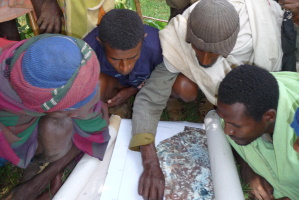 |
What's New
Successful side event on Fit For Purpose Land Administration
Implementation
|
What are the experiences with the current implementations of
Fit For Purpose Land Administration (FFP LA), what are lessons
learned and are there similarities when implementing the concept
in different places and contexts? |
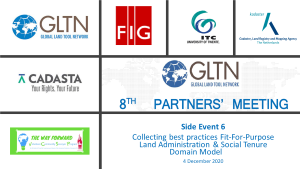
|
That were the key questions during the side event of the 8th GLTN
Partner Meeting at the beginning of December. FIG and other GLTN
partners such as Kadaster, Cadasta Foundation, ITC faculty of University
Twente and the VCSP reflected on the developments and provided a
foundation for an interactive debate.
Since the launch of the concepts STDM (2010) and Fit For Purpose Land
Administration (2014) partners of GLTN have contributed to the
implementation of these concepts in different places, different contexts
and at different levels all over the world. During this side event we
will focus on how, as partners, we can collect experiences and lessons
learned from projects in the world where principles of the FFP approach
and STDM were applied.
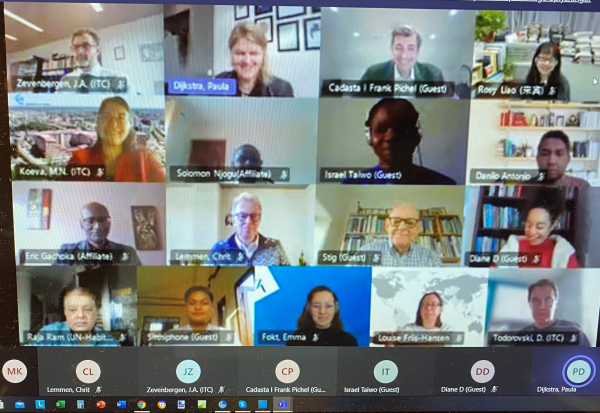
Best practices and inspiration for FFP LA implementation
At the start of the session Diane Dumashie (FIG) set the scene by
indicating that the FFP LA and STDM approaches are bridging mechanisms
for cooperation and that for further upscaling a publication on
implementations of FFP LA is key. As well as the importance of learning
from the different blockers in the processes and within our profession.
This was followed by an introduction of Paula Dijkstra on the efforts
of FIG towards the FFP LA implementation as well as an introduction on
the concepts of the continuum of land rights, FFP LA and STDM by Chrit
Lemmen. br />
Solomon Njogu presented on behalf of GLTN on how the concepts were
applied in different settings, with the valuable lessons learned. STDM
has become an important tool for tenure security improvement and a
valuable contribution to implementation of FFP LA.
The guide ‘Fit-For-Purpose Land Administration for All’ was
introduced by Eva-Maria Unger. This report shows the importance of
fostering strategic partnerships amongst all land sector stakeholders -
government, private sector, NGOs, and academia - when undertaking FFP
LA. The inspiring and spot-on graphics are a good addition to the
valuable content.
The Cadasta Foundation is involved in several implementation projects
and Frank Pichel inspired the participants on different methods that
were applied, as well how you can bridge the gap between top down and
bottom-up approaches. Also he shared the experiences on how the projects
were continued despite the unexpected ‘blocker’ of COVID-19.
The project Its4Land was concluded this year, with the delivery of
six new tools to make land rights mapping faster, cheaper, easier, and
more responsible. Mila Koeva from ITC, Faculty of University of Twente
presented the tools and linked them to the FFP LA principles.
Also the innovative Voluntary Community Surveying Program of FIG and
GLTN was presented by Israel Taiwo. He focused on how the next
generation of surveyors can be involved in the FFPLA processes through
VCSP.
Key take-aways:
- The concepts are bridging mechanisms for collaboration to
improve tenure security
- The concepts work! It delivers results on the grounds, focusing
on the needs and situation in the local setting
- The best practices show the relevance to focus on all three
frameworks, the spatial, institutional and legal framework.
- Blockers of the processes are in place, but these are similar or
linked and it is valuable to learn from how these blockers are
addressed.
- The involvement of all stakeholders and their joint ownership in
the whole process is key. Especially the involvement of the
surveyors and the land agencies.
- TThe participatory approach delivers and can be achieved in a
quick manner in several regions at the same time, really speeding up
the processes.
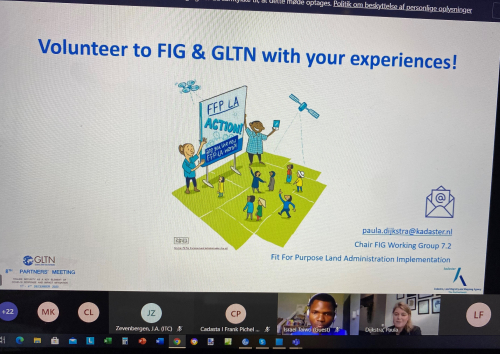
FIG Publication on FFP LA Implementation
The valuable insights from the session will be used in a publication
on Fit For Purpose Land Administration implementation. This publication
will be prepared by FIG and GLTN and supported by Kadaster and ITC. The
publication will reflect on how the concept was further developed since
the publication. Stakeholders involved with the implementation of FFP LA
will share their best practices and observations from their different
perspectives and backgrounds. Based on the collection of best practices
the publication will focus on recommendations to further accelerate the
efforts to document, record and recognize people to land relationships
in all forms.
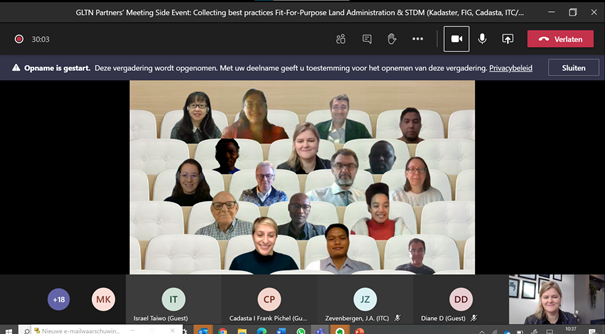
Some of the participants at the side event
Paula Dijkstra
December 2020
|




























